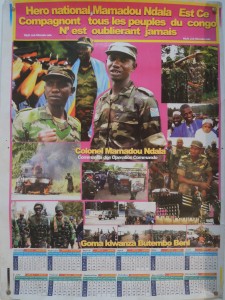I  Impressions from a short trip to Eastern Democratic Republic of Congo to research the plight of internally displaced people in January 2014.
Impressions from a short trip to Eastern Democratic Republic of Congo to research the plight of internally displaced people in January 2014.
Part 1: Mamadou Ndala and the (unbelievable) death of President Paul Kagame

Today the journal International Peacekeeping published my article on post-war conflict in the Democratic Republic of Congo. You may find a free link to the e-print version here (up to 50 clicks). Here’s a few excerpts…
While the EU comes under mounting pressure to turn a worsening refugee emergency in the Central Mediterranean, a tiny Italian village has succeeded in turning its own faith by offering desperate refugees homes and common hopes for the future.
 On 3 October 2013 the world witnessed the most dramatic human disaster in the Mediterranean Sea since the Second World War. Of a fishing boat that left Libyan waters with 518 Somali and Eritrean refugees, only 155 made it to the Italian island of Lampedusa. Rescue workers recuperated over 300 corpses from the swelling waters, while others remained stuck in the wreck. Survivors stated that a few passengers, including, apparently, the ship’s captain, set fire to a sheet to attract attention from passing vessels.
On 3 October 2013 the world witnessed the most dramatic human disaster in the Mediterranean Sea since the Second World War. Of a fishing boat that left Libyan waters with 518 Somali and Eritrean refugees, only 155 made it to the Italian island of Lampedusa. Rescue workers recuperated over 300 corpses from the swelling waters, while others remained stuck in the wreck. Survivors stated that a few passengers, including, apparently, the ship’s captain, set fire to a sheet to attract attention from passing vessels.
 On 28 August my co-edited volume with Benedikt Korf about ‘Violence on the Margins: States, Conflict, and Borderlands’ came out with Palgrave MacMillan Press (preview).
On 28 August my co-edited volume with Benedikt Korf about ‘Violence on the Margins: States, Conflict, and Borderlands’ came out with Palgrave MacMillan Press (preview).
 Four years ago Jeffrey Herbst and Greg Mills made a case for the abolishment of the Democratic Republic of Congo as a unitary state in favour of dealing with those agents and institutions that are “actually running” the country – a position against which I strongly reacted. Now they are back with a similar argument, which requires an equally strong reaction. A guest post by Christoph Vogel (cover picture courtesy of Justine Brabant)
Four years ago Jeffrey Herbst and Greg Mills made a case for the abolishment of the Democratic Republic of Congo as a unitary state in favour of dealing with those agents and institutions that are “actually running” the country – a position against which I strongly reacted. Now they are back with a similar argument, which requires an equally strong reaction. A guest post by Christoph Vogel (cover picture courtesy of Justine Brabant)
 The relationship between armed conflict and mining in the Democratic Republic of Congo is undergoing rapid and radical changes. This autumn, the new Fairphone has reached the production phase, based on certificates provided by the conflict-free tine initiative and Solutions for Hope projects in the Central African country. In the meantime, initiatives are competing for the public’s and market attention. Time for a critical update.
The relationship between armed conflict and mining in the Democratic Republic of Congo is undergoing rapid and radical changes. This autumn, the new Fairphone has reached the production phase, based on certificates provided by the conflict-free tine initiative and Solutions for Hope projects in the Central African country. In the meantime, initiatives are competing for the public’s and market attention. Time for a critical update.
The Democratic Republic of Congo is often represented as an isolated “Heart of Darkness”. Its booming cross-border trade nonetheless represents a powerful answer to state collapse and armed conflict and introduces new, surprisingly liberal, forms of government.
 Observers often agree that ‘history repeats itself’ in Eastern Congo – from the slavery conditions imposed by Belgian King Leopold over Mobutu’s predatory state, to today’s armed militias. The reason why these ghosts come haunting Congo’s present is primarily related to unending competition over the ‘right to protect’ unfree populations.
Observers often agree that ‘history repeats itself’ in Eastern Congo – from the slavery conditions imposed by Belgian King Leopold over Mobutu’s predatory state, to today’s armed militias. The reason why these ghosts come haunting Congo’s present is primarily related to unending competition over the ‘right to protect’ unfree populations.
The existence of such regionalized markets for protection in Congo’s eastern borderlands results in a situation whereby violent accumulation often outlives ideal statehood: soldiers, armed rebels, police and ‘non-state’ authorities fight for the right to exploit local communities and accumulate capital through extra-economic means. One the one hand, this pushes people further into poverty and undermines their efforts to earn a living; on the other, it leads to more stationary forms of predation as a result of post-war integration of such protection rackets into national state government. (cover picture courtesy Justine Brabant)
 This guest post by the The Committee of Congo-in-Europe describes the motives for the march of John Mpaliza and his friends to ask for justice in DR Congo. John is an inhabitant of Reggio Emilia (Italy) since 18 years. He left on foot from Reggio Emilia in July 2012 to reach the European capital, walking over 1.600 kilometres during one and a half months, and traversing seven European countries.
This guest post by the The Committee of Congo-in-Europe describes the motives for the march of John Mpaliza and his friends to ask for justice in DR Congo. John is an inhabitant of Reggio Emilia (Italy) since 18 years. He left on foot from Reggio Emilia in July 2012 to reach the European capital, walking over 1.600 kilometres during one and a half months, and traversing seven European countries.